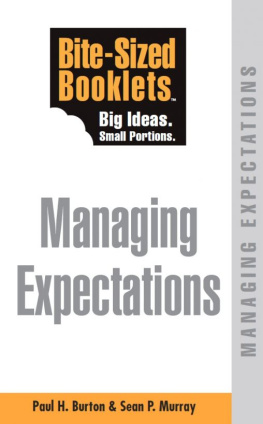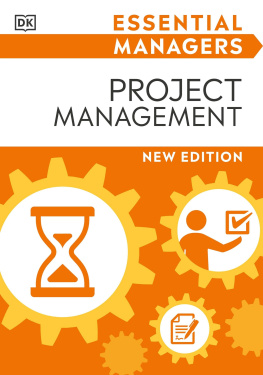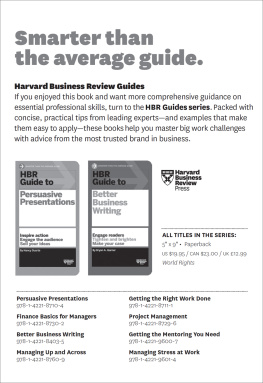Bite-Sized Books
Managing Expectations
Authors
Paul H. Burton, Principal, QuietSpacing,LLC
Sean Murray, CEO, RealTime Performance, Inc.
Bite-Sized Books: ManagingExpectations
by Paul H. Burton and Sean Murray
Copyright 2012 Paul H. Burton and SeanMurray
Smashwords Edition
This ebook is licensed for your personalenjoyment only. This ebook may not be re-sold or given away toother people. If you would like to share this book with anotherperson, please purchase an additional copy for each recipient. Ifyoure reading this book and did not purchase it, or it was notpurchased for your use only, then please return to Smashwords.comand purchase your own copy. Thank you for respecting the hard workof this author.
All rights reserved. No part of this book maybe used or reproduced in any manner whatsoever including Internetusage, without written permission of the author.
Digital edition produced by MaureenCutajar
www.gopublished.com
Table of Contents
ABOUT THE AUTHORS
Paul H. Burton, Principal, QuietSpacing,LLC. Paul helps people regain control of their day, get moredone, and enjoy greater career and personal success. When notdelivering presentations filled with time-making suggestions, Paultrains and coaches people on how to customize his revolutionaryQuietSpacing time-management method so that it fits their workstyle. You can learn more about Paul and his practice at www.quietspacing.com .
Sean Murray, CEO, RealTime Performance,Inc. Before founding RealTime Performance in 1999, Sean workedfor GE Capital at the Center for Learning and OrganizationalExcellence. In 2009, he coauthored the book Getting More fromYour Investment in Training: The 5As Framework. He also writesthe RealTime Leadership blog and serves on the board of thenonprofit Education Northwest. Sean has an undergraduate degreefrom the University of Puget Sound and a masters of businessadministration from the University of Oregon. You can learn moreabout Sean and his work at www.realtimeperformance.com .

Competitors: Just One Click Away
In a nondescript warehouse on the upperreaches of a beautiful resort town nestled in the shadow ofOregons Mount Hood, nine people join forces each week to servetheir customers. The business is Outdoorplay, Inc. It sellsrecreational gear on the Internet, the largest and most competitivemarketplace on earth.
Founded in the late 1990s, Outdoorplay roseduring the initial dot-com boom. It weathered the dot-com bust, andtoday it perseveres through the roller-coaster ride that is themodern global economy. Over the years, the company has grown into afreighter in an online ocean littered with supertankers. Alongsidethe largest of outdoor retailers (REI), competitors such asBackcountry.com and Alltrec.com ply the waters, marketing theirwares in innovative ways and acquiring new customers whiledesperately hoping to retain those already gotten.
Dozens of smaller players, such asOutdoorplay, constantly circle their bigger siblings, stealing abit of market share here and a bit of market share there. Theirmarketing budgets are no match for those of the major players, sothe secret sauce must be something unique... and less expensive.Most important, it must be effective. Once a shopper has landed ontheir website, its imperative to convert that person into acustomer. Thats because the competition is just one clickaway.
Outdoorplays secret sauce is surprisinglysimple. It excels at setting and managing customer expectations.Outdoorplay sets two expectations. The first is to help thecustomer make an informed buying decision about the technicalrecreational products it sells. This empowers the customer andengenders a sense of confidence in Outdoorplay, driving thecustomer to buy a particular item.
Once the customer makes a buying decision,he or she is informed that ground shipping will take five to sevendays. This is the second expectation Outdoorplay sets. Everycommunication with the customer reinforces this time period. Nomatter where the customer lives in relation to the company, thepackage will take five to seven days to arrive. Why is thisstressed so much? Because UPS can deliver 99.9 percent of itsground packages in five to seven days within the continental UnitedStates. If a package arrives a day earlier, Outdoorplay is a hero.If it arrives a day late, its a zero. This is another example ofhow Outdoorplay manages its customers expectations to maximize awin-win result.
The world of e-commerce happens atnear-light speeds, twenty-four hours a day, 365 days a year.Sometimes price drives the buying decision, but only sometimes.Often its more intangible thingsthe availability of the product,the reviews submitted by other customers, and the presentation andexplanation of the products for sale. An organization must fire onall cylinders all the time to stay alive when the competition is amere one click away.
In the end, though, it comes down torelationships between the business and the customer/client. Whatare the expectations between them? Who sets those expectations? Howare they being managed? One of the most satisfactory experiences inlifepersonal or professionalis having our expectations met. Itmakes us feel good, well attended to, even sated.
(Of course, the rarified air of exceedingexpectations is even better. However, beware of the rhetoric ofmarketing that is actually a trap for the unwary. The trap? Settingan unattainable expectation, which leads to disappointmentbeing azero!)
Below we focus on how to properly setexpectations and how to manage them to maximize the likelihood ofsuccess. Along the way, we will share proven strategies for successin leveraging this ancient concept in the digital age.
First, well explore how properly settingand managing expectations can help us be more productive andfacilitate achieving our goals. Then well share strategies fortaking advantage of the power of this tool to make us productiveand effective while mitigating the negative side effects.
ManagingExpectations: The Tactical Perspective
Quick! Grab a pen and write the answer tothe following question on the line provided below. Ready?
When is ASAP?
_____________________________________
Trick question? Stunt? Hardly. This is themost oft-delivered deadline for delegated assignments, yet no onecan clearly define when the actual due date is. In a world measuredin nanoseconds, its patently absurd that weve been reduced tomeaningless initialisms for setting deadlines on important workthat needs to be done.
Frankly, its lazy management. Whether itsASAP or its many relatives (Urgent, TopPriority, and Immediately), using terms of vague urgencyonly increases the stress level for everyone present with nocorresponding increase in productivity. Arguably, this self-createdconfusion about when things are really needed has the reverseeffect. It reduces productivity and lowers performance becauseemployees flit from one project to the next, desperately trying toferret out which of ten ASAPs should be done first.
This is but one example of what we can labela rash of urgency in the modern working environment. Things havebecome so urgent that we no longer have time to put a specificdeadline on the work being handed around!
How did we come to this juncture? Moreimportant, what can we do to stop playing Whac-A-Mole with ourworkloads? The answer is to fundamentally reassess the notion ofsetting and managing expectations. We need to embrace the idea thatslowing downjust a smidgeat the right times can accelerate ourproductivity and result in happier clients/customers and lessstress and burnout in our people and ourselves.














